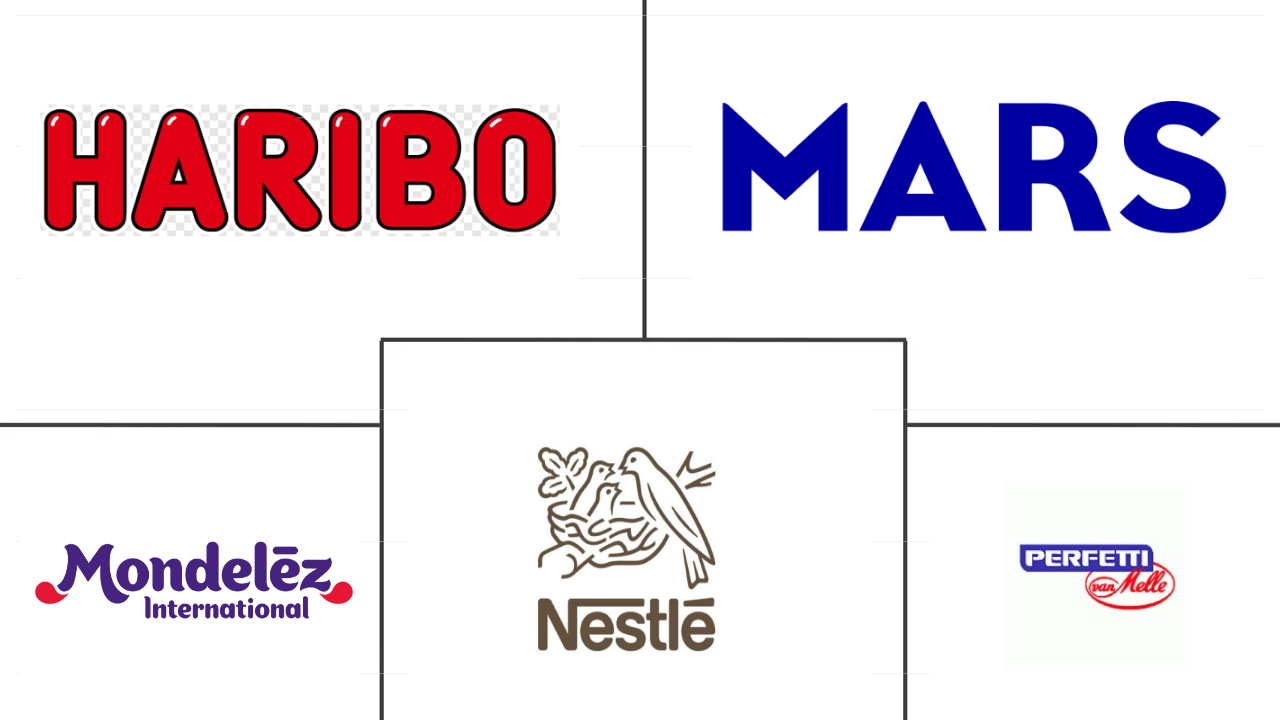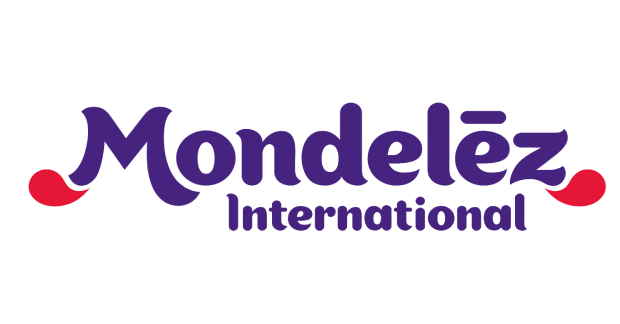Market Size of sugar confectionery Industry
| Icons | Lable | Value |
|---|---|---|
|
|
Study Period | 2018 - 2030 |
|
|
Market Size (2024) | USD 57.45 Billion |
|
|
Market Size (2030) | USD 81.88 Billion |
|
|
Largest Share by Distribution Channel | Convenience Store |
|
|
CAGR (2024 - 2030) | 6.08 % |
|
|
Largest Share by Region | North America |
|
|
Market Concentration | Low |
Major Players |
||

|
||
|
*Disclaimer: Major Players sorted in no particular order |
Sugar Confectionery Market Analysis
The Sugar Confectionery Market size is estimated at 57.45 billion USD in 2024, and is expected to reach 81.88 billion USD by 2030, growing at a CAGR of 6.08% during the forecast period (2024-2030).
57.45 Billion
Market Size in 2024 (USD)
81.88 Billion
Market Size in 2030 (USD)
3.21 %
CAGR (2018-2023)
6.08 %
CAGR (2024-2030)
Largest Segment by Confectionery Variant
38.76 %
value share, Pastilles, Gummies, and Jellies, Gummies
The impact of innovative flavor profiles, along with consequent shelf space in supermarkets and hypermarkets, is anticipated to drive the impulse purchasing of these products.
Largest Segment by Distribution Channel
40.63 %
value share, Convenience Store, 2023
The feasible locations of convenience stores allow consumers to shop within minimal distances with wider chocolate product availability, making it major segment of the market.
Fastest-growing Segment by Confectionery variant
6.42 %
Projected CAGR, Pastilles, Gummies, and Jellies, Gummies
The increased interest of consumers in new sweet confections with innovative flavor, color, and shape preferences, especially from kids, is largely driving segmental growth.
Fastest-growing Segment by Distribution Channel
6.79 %
Projected CAGR, Online Retail Store, 2024-2030
With the huge intensity of internet penetration, consumers are purchasing confectionery products through online stores, anticipating it to be the fastest-growing segment.
Leading Market Player
6.76 %
market share, Mondelēz International Inc., 2022

The company's main focus on product development made Mondelēz a market leader. It has been ramping up its existing range of products, highly influencing consumer behavior.
Online retail is likely to be the fastest-growing channel owing to benefits like timeliness, convenience, and quick delivery, registering a Y-o-Y growth rate of 6.10% over 2023-2024
- Distribution channels in the global sugar confectionery market maintained a value growth rate of 5.03% in 2023 compared to 2022. The growth is expected to be driven by consumers' increasing preference for convenient shopping options in the market. Factors such as increasing preference for in-person shopping, increasing demand for discount offers, etc., are expected to significantly boost the retail industry during the forecast period. By volume, global retailing units were expected to grow by 4.65% in 2023.
- By value, online retail channels are likely to be the fastest-growing channels. The segment was anticipated to attain a value growth rate of 37.76% in 2023 compared to the year 2022. Online stores allow consumers to select from a large collection of product offerings marketed under private labels as well as mainstream brands. Also, online channels provide bulk purchase discounts and coupon codes to attract potential buyers, which, in turn, influences the online sales of confectionery.
- Convenience stores are the largest-growing segment in the global sugar confectionery market. The sales value of sugar confectionery products through convenience stores registered a growth rate of 4.93% in 2023 compared to the previous year, 2022. The growth is primarily because of the positioning of confectionery products such as chocolates, candies, and gums at the checkout counter, which fuels consumers' impulse buying.
- Supermarkets are the second-leading channel through which sugar confectionery is consumed. In 2023, the segment witnessed a value growth rate of 4.64% compared to 2022. The increasing sugar confectionery sales through supermarkets is primarily because of the extensive availability of several brands under one roof.
North America is the largest revenue-generating region, with its rising volume of consumers with a sweet tooth
- The global sugar confectionery market observed a growth rate of 4.7% by value in 2023 compared to 2022. The growing trend is mainly due to the rising adoption of convenient bite-size snacking via sugar confectionery like toffees, hard candies, and jellies, and the increasing use of sugar confectionery in the formulation of a wide variety of beverage and confectionery products, such as cakes, milkshakes, croissants, and hot sugar, which is contributing to the global sugar confectionery market's growth.
- North America is the largest regional market, attaining a value growth rate of 5.76% in 2023 from 2022. Its growth is anticipated due to the rising volume of consumers with a sweet tooth across the region. Despite the rise in healthier eating, the rise in candy sales has been favorable over the years. Consumers across the region tend to have a habit of incorporating candy and sweets into their diet as post-meal treats or snacks. In 2022, the average American ate (or drank) 34 teaspoons of sugar a day, equal to 500+ calories. Out of this, 10% of the sugar in the average person’s diet comes from candy.
- Africa is the fastest-growing region in the overall sugar confectionery market and is likely to attain a value growth rate of 31.06% during the forecast period (2024-2030). The availability of sugar confections in unique flavors, such as Nurungji and Honey-Filled Candy, is attracting the African population. The gummies and jellies variant is considered the largest segment in the sugar-confectionery industry in Africa, with a 34% share in 2023. Consumers are attracted by the availability of these confections in unique textures, flavors, and colors. Thus, the innovations in the segment are likely to boost the region's sales during the forecast period.
Sugar Confectionery Industry Segmentation
Hard Candy, Lollipops, Mints, Pastilles, Gummies, and Jellies, Toffees and Nougats, Others are covered as segments by Confectionery Variant. Convenience Store, Online Retail Store, Supermarket/Hypermarket, Others are covered as segments by Distribution Channel. Africa, Asia-Pacific, Europe, Middle East, North America, South America are covered as segments by Region.
- Distribution channels in the global sugar confectionery market maintained a value growth rate of 5.03% in 2023 compared to 2022. The growth is expected to be driven by consumers' increasing preference for convenient shopping options in the market. Factors such as increasing preference for in-person shopping, increasing demand for discount offers, etc., are expected to significantly boost the retail industry during the forecast period. By volume, global retailing units were expected to grow by 4.65% in 2023.
- By value, online retail channels are likely to be the fastest-growing channels. The segment was anticipated to attain a value growth rate of 37.76% in 2023 compared to the year 2022. Online stores allow consumers to select from a large collection of product offerings marketed under private labels as well as mainstream brands. Also, online channels provide bulk purchase discounts and coupon codes to attract potential buyers, which, in turn, influences the online sales of confectionery.
- Convenience stores are the largest-growing segment in the global sugar confectionery market. The sales value of sugar confectionery products through convenience stores registered a growth rate of 4.93% in 2023 compared to the previous year, 2022. The growth is primarily because of the positioning of confectionery products such as chocolates, candies, and gums at the checkout counter, which fuels consumers' impulse buying.
- Supermarkets are the second-leading channel through which sugar confectionery is consumed. In 2023, the segment witnessed a value growth rate of 4.64% compared to 2022. The increasing sugar confectionery sales through supermarkets is primarily because of the extensive availability of several brands under one roof.
| Confectionery Variant | |
| Hard Candy | |
| Lollipops | |
| Mints | |
| Pastilles, Gummies, and Jellies | |
| Toffees and Nougats | |
| Others |
| Distribution Channel | |
| Convenience Store | |
| Online Retail Store | |
| Supermarket/Hypermarket | |
| Others |
| Region | |||||||||||||||
| |||||||||||||||
| |||||||||||||||
| |||||||||||||||
| |||||||||||||||
| |||||||||||||||
|
Sugar Confectionery Market Size Summary
The sugar confectionery market is experiencing a robust expansion, driven by evolving consumer preferences and innovative distribution channels. The market is characterized by a significant shift towards online retailing, which is rapidly becoming the fastest-growing channel due to its extensive product offerings and attractive discounts. Convenience stores are also witnessing substantial growth, largely due to strategic product placements that encourage impulse buying. Supermarkets remain a key player in the market, offering a wide range of brands under one roof, which continues to attract consumers. The market's growth is further fueled by the increasing popularity of bite-size snacking and the incorporation of sugar confectionery in various food and beverage products, such as cakes and milkshakes.
Regionally, North America leads the market, with a strong consumer base that enjoys incorporating sweets into their diets despite a trend towards healthier eating. Africa is emerging as the fastest-growing region, with unique flavors and textures attracting a diverse consumer base. The Asia-Pacific region shows a preference for hard candies, particularly during travel and work. The market is fragmented, with major players like HARIBO, Mars, Mondelēz, Nestlé, and Perfetti Van Melle holding significant shares. Recent developments, such as new manufacturing facilities and product launches, underscore the dynamic nature of the market, catering to the growing demand for innovative and appealing sugar confectionery products.
Sugar Confectionery Market Size - Table of Contents
-
1. MARKET SEGMENTATION (includes market size in Value in USD and Volume, Forecasts up to 2030 and analysis of growth prospects)
-
1.1 Confectionery Variant
-
1.1.1 Hard Candy
-
1.1.2 Lollipops
-
1.1.3 Mints
-
1.1.4 Pastilles, Gummies, and Jellies
-
1.1.5 Toffees and Nougats
-
1.1.6 Others
-
-
1.2 Distribution Channel
-
1.2.1 Convenience Store
-
1.2.2 Online Retail Store
-
1.2.3 Supermarket/Hypermarket
-
1.2.4 Others
-
-
1.3 Region
-
1.3.1 Africa
-
1.3.1.1 By Country
-
1.3.1.1.1 Egypt
-
1.3.1.1.2 Nigeria
-
1.3.1.1.3 South Africa
-
1.3.1.1.4 Rest of Africa
-
-
-
1.3.2 Asia-Pacific
-
1.3.2.1 By Country
-
1.3.2.1.1 Australia
-
1.3.2.1.2 China
-
1.3.2.1.3 India
-
1.3.2.1.4 Indonesia
-
1.3.2.1.5 Japan
-
1.3.2.1.6 Malaysia
-
1.3.2.1.7 New Zealand
-
1.3.2.1.8 South Korea
-
1.3.2.1.9 Rest of Asia-Pacific
-
-
-
1.3.3 Europe
-
1.3.3.1 By Country
-
1.3.3.1.1 Belgium
-
1.3.3.1.2 France
-
1.3.3.1.3 Germany
-
1.3.3.1.4 Italy
-
1.3.3.1.5 Netherlands
-
1.3.3.1.6 Russia
-
1.3.3.1.7 Spain
-
1.3.3.1.8 Switzerland
-
1.3.3.1.9 Turkey
-
1.3.3.1.10 United Kingdom
-
1.3.3.1.11 Rest of Europe
-
-
-
1.3.4 Middle East
-
1.3.4.1 By Country
-
1.3.4.1.1 Bahrain
-
1.3.4.1.2 Kuwait
-
1.3.4.1.3 Oman
-
1.3.4.1.4 Qatar
-
1.3.4.1.5 Saudi Arabia
-
1.3.4.1.6 United Arab Emirates
-
1.3.4.1.7 Rest of Middle East
-
-
-
1.3.5 North America
-
1.3.5.1 By Country
-
1.3.5.1.1 Canada
-
1.3.5.1.2 Mexico
-
1.3.5.1.3 United States
-
1.3.5.1.4 Rest of North America
-
-
-
1.3.6 South America
-
1.3.6.1 By Country
-
1.3.6.1.1 Argentina
-
1.3.6.1.2 Brazil
-
1.3.6.1.3 Rest of South America
-
-
-
-
Sugar Confectionery Market Size FAQs
How big is the Global Sugar Confectionery Market?
The Global Sugar Confectionery Market size is expected to reach USD 57.45 billion in 2024 and grow at a CAGR of 6.08% to reach USD 81.88 billion by 2030.
What is the current Global Sugar Confectionery Market size?
In 2024, the Global Sugar Confectionery Market size is expected to reach USD 57.45 billion.

